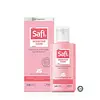What's inside
What's inside
 Key Ingredients
Key Ingredients

 Benefits
Benefits

 Concerns
Concerns

 Ingredients Side-by-side
Ingredients Side-by-side

Water
Skin ConditioningSodium Lauryl Sulfate
CleansingGlycerin
HumectantAcrylates Copolymer
Cocamidopropyl Betaine
CleansingLauryl Glucoside
CleansingPotassium Cocoyl Glycinate
Polysorbate 20
EmulsifyingCocamide Methyl Mea
Mannitol
HumectantHydroxyacetophenone
AntioxidantMenthol
MaskingPEG-14m
Emulsion StabilisingSodium Hydroxide
BufferingBenzotriazolyl Dodecyl P-Cresol
UV AbsorberTetrasodium EDTA
Microcrystalline Cellulose
AbsorbentZinc Lactate
Mandelic Acid
AntimicrobialHydroxypropyl Methylcellulose
Emulsion StabilisingMelia Azadirachta Leaf Extract
Skin ConditioningMelaleuca Alternifolia Leaf Oil
AntioxidantTocopheryl Acetate
AntioxidantBorago Officinalis Seed Oil
EmollientSalicylic Acid
MaskingArginine
MaskingPerfluorodecalin
Skin ConditioningButylene Glycol
Humectant4-Butylresorcinol
AntioxidantDextrin
AbsorbentSimmondsia Chinensis Seed Oil
EmollientLecithin
EmollientGlycosphingolipids
EmollientSucrose Palmitate
EmollientXanthan Gum
EmulsifyingParfum
MaskingSodium Metabisulfite
AntioxidantPhenoxyethanol
PreservativePotassium Sorbate
PreservativeSodium Benzoate
MaskingCI 12490
Cosmetic ColorantWater, Sodium Lauryl Sulfate, Glycerin, Acrylates Copolymer, Cocamidopropyl Betaine, Lauryl Glucoside, Potassium Cocoyl Glycinate, Polysorbate 20, Cocamide Methyl Mea, Mannitol, Hydroxyacetophenone, Menthol, PEG-14m, Sodium Hydroxide, Benzotriazolyl Dodecyl P-Cresol, Tetrasodium EDTA, Microcrystalline Cellulose, Zinc Lactate, Mandelic Acid, Hydroxypropyl Methylcellulose, Melia Azadirachta Leaf Extract, Melaleuca Alternifolia Leaf Oil, Tocopheryl Acetate, Borago Officinalis Seed Oil, Salicylic Acid, Arginine, Perfluorodecalin, Butylene Glycol, 4-Butylresorcinol, Dextrin, Simmondsia Chinensis Seed Oil, Lecithin, Glycosphingolipids, Sucrose Palmitate, Xanthan Gum, Parfum, Sodium Metabisulfite, Phenoxyethanol, Potassium Sorbate, Sodium Benzoate, CI 12490
Water
Skin ConditioningEthylhexyl Palmitate
EmollientGlycerin
HumectantDipropylene Glycol
HumectantDimethicone
EmollientCyclopentasiloxane
EmollientCyclohexasiloxane
EmollientPolyacrylate-13
Methyl Methacrylate Crosspolymer
Ethylhexyl Methoxycinnamate
UV AbsorberAllantoin
Skin ConditioningDimethicone Crosspolymer
Emulsion StabilisingCarbomer
Emulsion StabilisingBisabolol
MaskingSodium Hydroxide
BufferingDisodium EDTA
Niacinamide
SmoothingTocopheryl Acetate
AntioxidantAlpha-Glucan Oligosaccharide
CleansingPEG-7 Glyceryl Cocoate
EmulsifyingPolymnia Sonchifolia Root Juice
Skin ConditioningAloe Barbadensis Leaf Extract
EmollientMaltodextrin
AbsorbentCeramide NP
Skin ConditioningLactobacillus
Skin ConditioningPhenoxyethanol
PreservativeChlorphenesin
AntimicrobialWater, Ethylhexyl Palmitate, Glycerin, Dipropylene Glycol, Dimethicone, Cyclopentasiloxane, Cyclohexasiloxane, Polyacrylate-13, Methyl Methacrylate Crosspolymer, Ethylhexyl Methoxycinnamate, Allantoin, Dimethicone Crosspolymer, Carbomer, Bisabolol, Sodium Hydroxide, Disodium EDTA, Niacinamide, Tocopheryl Acetate, Alpha-Glucan Oligosaccharide, PEG-7 Glyceryl Cocoate, Polymnia Sonchifolia Root Juice, Aloe Barbadensis Leaf Extract, Maltodextrin, Ceramide NP, Lactobacillus, Phenoxyethanol, Chlorphenesin
Ingredients Explained
These ingredients are found in both products.
Ingredients higher up in an ingredient list are typically present in a larger amount.
Glycerin is already naturally found in your skin. It helps moisturize and protect your skin.
A study from 2016 found glycerin to be more effective as a humectant than AHAs and hyaluronic acid.
As a humectant, it helps the skin stay hydrated by pulling moisture to your skin. The low molecular weight of glycerin allows it to pull moisture into the deeper layers of your skin.
Hydrated skin improves your skin barrier; Your skin barrier helps protect against irritants and bacteria.
Glycerin has also been found to have antimicrobial and antiviral properties. Due to these properties, glycerin is often used in wound and burn treatments.
In cosmetics, glycerin is usually derived from plants such as soybean or palm. However, it can also be sourced from animals, such as tallow or animal fat.
This ingredient is organic, colorless, odorless, and non-toxic.
Glycerin is the name for this ingredient in American English. British English uses Glycerol/Glycerine.
Learn more about GlycerinPhenoxyethanol is a preservative that has germicide, antimicrobial, and aromatic properties. Studies show that phenoxyethanol can prevent microbial growth. By itself, it has a scent that is similar to that of a rose.
It's often used in formulations along with Caprylyl Glycol to preserve the shelf life of products.
Sodium Hydroxide is also known as lye or caustic soda. It is used to adjust the pH of products; many ingredients require a specific pH to be effective.
In small amounts, sodium hydroxide is considered safe to use. However, large amounts may cause chemical burns due to its high alkaline.
Your skin has a natural pH and acid mantle. This acid mantle helps prevent harmful bacteria from breaking through. The acid mantle also helps keep your skin hydrated.
"Alkaline" refers to a high pH level. A low pH level would be considered acidic.
Learn more about Sodium HydroxideTocopheryl Acetate is AKA Vitamin E. It is an antioxidant and protects your skin from free radicals. Free radicals damage the skin by breaking down collagen.
One study found using Tocopheryl Acetate with Vitamin C decreased the number of sunburned cells.
Tocopheryl Acetate is commonly found in both skincare and dietary supplements.
Learn more about Tocopheryl AcetateWater. It's the most common cosmetic ingredient of all. You'll usually see it at the top of ingredient lists, meaning that it makes up the largest part of the product.
So why is it so popular? Water most often acts as a solvent - this means that it helps dissolve other ingredients into the formulation.
You'll also recognize water as that liquid we all need to stay alive. If you see this, drink a glass of water. Stay hydrated!
Learn more about Water